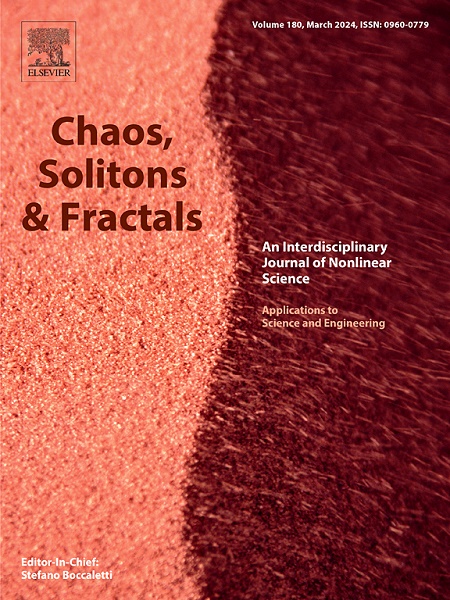Design and application of spatial multi-structure hidden attractors in memristor-coupled heterogeneous neural networks
IF 5.3
1区 数学
Q1 MATHEMATICS, INTERDISCIPLINARY APPLICATIONS
引用次数: 0
Abstract
Biomimetic modeling, through memristors coupling different numbers of heterogeneous neurons, holds extraordinary significance for exploring brain science. To expand the diversity of models related to multi-structure attractors, this paper first proposes a novel multi-segment memristor, and then uses it to couple a 4D Hopfield neural network (HNN) and a 2D Hindmarsh-Rose (HR) neuron. This coupling method simulates the electromagnetic induction effect and mutual-synapses between neurons, thereby constructing a new type of memristor-coupled heterogeneous neural network (MCH-NN) with multi-structure chaotic attractors. This innovative model provides a new perspective for exploring multi-structure behaviors in neural networks. Theoretical research and numerical simulations indicate: (1) In the analysis of the generation mechanism of multi-structure chaotic attractors, its rare hidden characteristics are revealed. (2) This is the first time that arbitrarily controllable quantities of 1D (unidirectional)-, 2D (grid)-, and 3D (spatial)- multi-structure hidden attractors (MSHAs) have been detected in heterogeneous neural networks. Notably, the number of MSHAs is determined by the control parameters of the memristor. (3) The coupling strength significantly affects the dynamic evolution of MCH-NN, and dual-parameter dynamic evolution analysis further confirms this. (4) MCH-NN exhibits rich hidden dynamic characteristics, such as spatial initial offset and spatial amplitude control. Interestingly, mirror-symmetric and mirror-asymmetric MSHAs were also discovered when adjusting the amplitude control parameters. Furthermore, its practical feasibility is validated through analog circuit and digital hardware experiments. Finally, based on MCH-NN, incorporating adaptive filtering denoising technology and spread spectrum communication technology, a novel chaos shift keying (CSK) secure communication scheme is designed, and is intended for binary digital information transmission under low signal-to-noise ratio (SNR) environments. The results demonstrate that this scheme has strong anti-noise performance and excellent communication capabilities.
记忆电阻器耦合异构神经网络中空间多结构隐吸引子的设计与应用
通过忆阻器耦合不同数量的异质神经元进行仿生建模,对于探索脑科学具有重要意义。为了扩大多结构吸引子相关模型的多样性,本文首先提出了一种新的多段记忆电阻,然后将其用于耦合4D Hopfield神经网络(HNN)和2D Hindmarsh-Rose (HR)神经元。这种耦合方法模拟了神经元之间的电磁感应效应和相互突触,从而构建了一种具有多结构混沌吸引子的新型忆阻器耦合异质神经网络(MCH-NN)。这一创新模型为探索神经网络中的多结构行为提供了新的视角。理论研究和数值模拟表明:(1)在对多结构混沌吸引子产生机理的分析中,揭示了其罕见的隐藏特性。(2)首次在异质神经网络中检测到任意可控数量的1D(单向)-、2D(网格)-和3D(空间)-多结构隐藏吸引子(MSHAs)。值得注意的是,MSHAs的数量是由忆阻器的控制参数决定的。(3)耦合强度显著影响MCH-NN的动态演化,双参数动态演化分析进一步证实了这一点。(4) MCH-NN具有丰富的隐藏动态特性,如空间初始偏移和空间幅度控制。有趣的是,当调整幅度控制参数时,也发现了镜像对称和镜像不对称的MSHAs。并通过模拟电路和数字硬件实验验证了其实际可行性。最后,基于MCH-NN,结合自适应滤波去噪技术和扩频通信技术,设计了一种新的混沌移位键控(CSK)保密通信方案,用于低信噪比(SNR)环境下二进制数字信息的传输。结果表明,该方案具有较强的抗噪声性能和良好的通信性能。
本文章由计算机程序翻译,如有差异,请以英文原文为准。
求助全文
约1分钟内获得全文
求助全文
来源期刊

Chaos Solitons & Fractals
物理-数学跨学科应用
CiteScore
13.20
自引率
10.30%
发文量
1087
审稿时长
9 months
期刊介绍:
Chaos, Solitons & Fractals strives to establish itself as a premier journal in the interdisciplinary realm of Nonlinear Science, Non-equilibrium, and Complex Phenomena. It welcomes submissions covering a broad spectrum of topics within this field, including dynamics, non-equilibrium processes in physics, chemistry, and geophysics, complex matter and networks, mathematical models, computational biology, applications to quantum and mesoscopic phenomena, fluctuations and random processes, self-organization, and social phenomena.
 求助内容:
求助内容: 应助结果提醒方式:
应助结果提醒方式:


